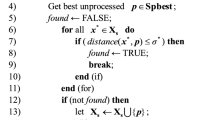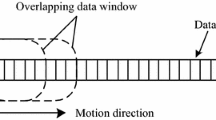Abstract
Multiple signal classification (MUSIC) algorithm has been widely used to obtain high-resolution frequency estimation for an accurate identification of frequency components in low signal-to-noise ratios. One of the main drawbacks associated with the use of the MUSIC algorithm is that its performance is fully deteriorated when a wrong frequency signal dimension order is chosen, producing that some spurious frequencies could appear or some signal frequencies could be missing. In this paper, it is proposed a multi-objective optimization method to address the frequency signal dimension order problem. The proposed approach is based on a novel feature extraction of frequency components, which allows determining an adequate frequency signal dimension order. The methodology has been integrated as part of the MUSIC algorithm, and it can find the optimal order within a predefined frequency bandwidth, where the user is interested to find a frequency component. To evaluate the effectiveness of the proposed methodology, experimental results from several current signals obtained in the detection of broken rotor bar fault in induction motors have been tested.







Similar content being viewed by others
References
Toliyat HA, Kliman GB (2004) Handbook of electric motors. CRC Press, USA
Castanié F (2013) Digital spectral analysis parametric non-parametric and advanced methods. Wiley, USA
Qing H, Liu Y, Xie G, Gao J (2015) Wideband spectrum sensing for cognitive radios: a multistage wiener filter perspective. Signal Process Lett 22:332–335
Lustosa da Costa J, Roemer F, Schulz D, Sousa R (2011) Subspace based multi-dimensional model order selection in colored noise scenarios. Information Theory Workshop, pp 380–384
Jung J-H, Jong-Jae L, Kwon B-H (2006) Online diagnosis of induction motors using mcsa. Trans Ind Electron 53(6):1842–1852
Wen F, Wan Q, Fan R, Wei H (2014) Improved MUSIC algorithm for multiple noncoherent subarrays. Signal Process Lett 21:527–530
Kumar L, Tripathy A, Hegde RM (2014) Robust multi-source localization over planar arrays using MUSIC-group delay spectrum. Trans Signal Process 62:4627–4636
Feng-Gang Y, Jin M, Liu S, Xiao-Lin Q (2014) Real-valued MUSIC for efficient direction estimation with arbitrary array geometries. Trans Signal Process 62:1548–1560
Zhang S, Zhu Y, Kuang G (2015) Imaging of downward-looking linear array three-dimensional SAR based on FFT-MUSIC. Geosci Remote Sens Lett 12:885–889
Fouda AE, Teixeira FL (2014) Statistical stability of ultrawideband time-reversal imaging in random media. Trans Geosci Remote Sens 52(2):870–879
Sit YL, Sturm C, Baier J, Zwick T (2012) Direction of arrival estimation using the MUSIC algorithm for a MIMO OFDM radar. In: 2012 IEEE radar conference (RADAR), Atlanta, USA, May 7–11, 2012. IEEE, Piscataway, NJ, pp 226–229
Huang Y, Hu A, Xie S, Zhu D, Xue M (2014) An integer time delay estimation algorithm based on Zadoff-Chu sequence in OFDM systems. Trans Veh Technol 63:2941–2947
Jover Rodríguez PV, Belahcen A, Arkkio A (2008) Air-gap force distribution and vibration pattern of Induction motors under dynamic eccentricity. Electr Eng 90:209–2018
Urresty J-C, Riba J-R, Romeral L (2015) Mixed resistive unbalance and winding inter-turn faults model of permanent magnet synchronous motors. Electr Eng 97:75–85
Bouchikhi EHE, Choqueuse V, Benbouzid M (2015) Induction machine faults detection using stator current parametric spectral estimation. Mech Syst Signal Process 52–53:447–464
Garcia-Perez A, Romero-Troncoso RJ, Cabal-Yepez E, Osornio-Rios RA (2011) The application of high-resolution spectral analysis for identifying multiple combined faults in induction motors. Trans Ind Electron 58(5):2002–2010
Garcia-Perez A, Romero-Troncoso R J, Cabal-Yepez E, Osornio-Rios R A, Rangel-Magdaleno JJ, Miranda H (2011) Startup current analysis of incipient broken rotor bar in induction motors using high-resolution spectral analysis. In: International symposium on diagnostics for electric machines, power electronics & drives, pp 657–663
Kim B, Lee K, Yang J, Lee S, Wiedenbrug EJ, Shah MR (2011) Automated detection of rotor faults for inverter-fed induction machines under standstill conditions. Trans Ind Appl 47(1):55–64
Gyftakis KN, Spyropoulos DV, Kappatou JC, Mitronikas ED (2013) A novel approach for broken bar fault diagnosis in induction motors through torque monitoring. Trans Energy Convers 28(2):267–277
Kia SH, Henao H, Capolino G-A (2007) A high-resolution frequency estimation method for three-phase induction machine fault detection. Ind Electron IEEE Trans 54(4):2305–2314
Kim Y-H, Youn Y-W, Hwang D-H, Sun J-H, Kang D-S (2013) High-resolution parameter estimation method to identify broken rotor bar faults in induction motors. Trans Ind Electron 60(9):4103–4117
Radoi E, Quinquis A (2004) A new method for estimating the number of harmonic components in noise with application in high resolution radar. J Appl Signal Process 1177–1188
Zhou A, Qu B-Y, Li H, Zhao S-Z, Suganthan PN, Zhang Q (2011) Multiobjective evolutionary algorithms: a survey of the state of the art. Swarm Evol Comput 1:32–49
Marler RT, Arora JS (2010) The weighted sum method for multi-objective optimization: new insights. Struct Multidiscip Optim 41:853–862
Duda RO, Hart PE, Stork DG (2000) Pattern classification, 2nd edn. Wiley, New York
Göktaş T, Arkan M, Faruk Özgüven A (2015) Detection of rotor fault in three-phase induction motor in case of low-frequency load oscillation. http://link.springer.com/article/10.1007/s00202-015-0342-5. Accessed 15 Aug 2015
Antonino-Daviu J, Aviyente S, Strangas EG, Riera-Guasp M (2013) Scale invariant feature extraction algorithm for the automatic diagnosis of rotor asymmetries in induction motors. Trans Ind Electron 9(1):100–108
Author information
Authors and Affiliations
Corresponding author
Rights and permissions
About this article
Cite this article
Trejo-Caballero, G., Rostro-Gonzalez, H., Romero-Troncoso, R.d.J. et al. Multiple signal classification based on automatic order selection method for broken rotor bar detection in induction motors. Electr Eng 99, 987–996 (2017). https://doi.org/10.1007/s00202-016-0463-5
Received:
Accepted:
Published:
Issue Date:
DOI: https://doi.org/10.1007/s00202-016-0463-5




